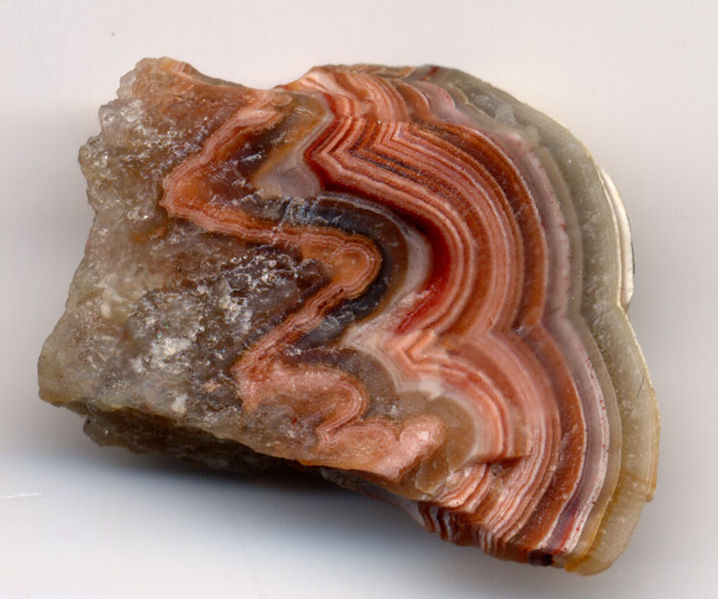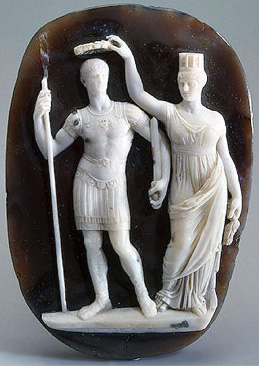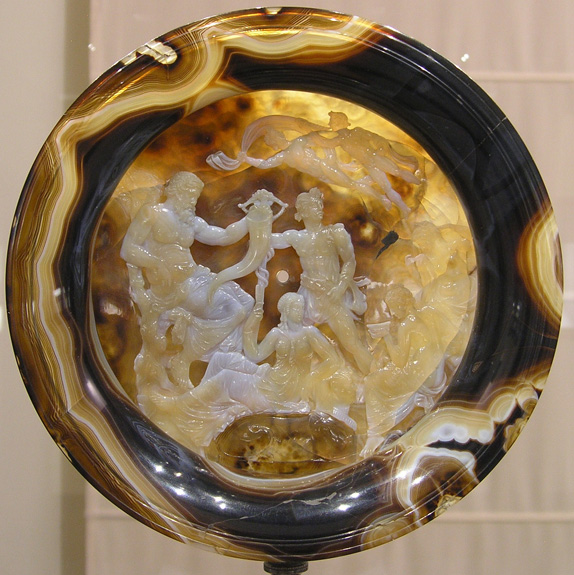Sardonyx
Sardonyx is a variety of onyx which is typically "striped" and can have the appearance of the "rings" of a sawn tree-trunk, as can be seen in the topmost image. Sardonyx differs from regular onyx in that the dark bands are red or reddish brown, instead of black. The red bands are layers of sard, hence the name. It has similar general properties to onyx.

Sardonyx
Sardonyx is a chalcedony - and like other chalcedonies, it is a cryptocrystalline quartz with the general chemical formula SiO2. Cryptocrystalline rock is made up of crystals that are so small that even using a microscope, specialized techniques using polarized light are required in order to see that the stone is made up of crystals. [1]
Sardonyx has been used as a decorative stone and carved since ancient times. It was found during archaeology at the site of Knossos, part of the Minoan civilisation on the Island of Crete. [1] In Roman times, it was fashionable to make cameos - small carved figures - using stones such as sardonyx. The stone's natural banding was typically aligned so that the "field" or background of the carving would be revealed in one colour, (usually dark) with the subject in relief in another color. Many examples of these objects still exist and are a testament to the great skill and commitment of the craftsmen of those times. It's said that sardonyx was especially prized by the Romans for use in making seals, as rather than sticking, it peeled away cleanly from the wax - a necessary characteristic if one wishes to make the perfect imprint. [2]
The Romans also believed that sardonyx gave power to orators, and brought courage and victory in battle. [3] This was probably on account of its red color, which according to the "doctrine of signatures", meant that the stone was associated with Mars - the God of war, courage and leadership. Interestingly, it is now known that the coloration of sard is due to iron oxide - and iron was considered the "planetary metal" associated with Mars. Another ancient belief about sardonyx was that it brought happiness and stability to marriage. [3]
Sardonyx was mentioned in the Bible - in Chater 21 of the Book of Revelation; although some translations translate the original as onyx. It is sometimes difficult for modern translators of ancient books to be sure of the exact identity of a stone that was being described - and this phenomenon is widespread in the world of gems.
Nowadays sardonyx is still seen on the marketplace, but very often in the form of simpler objects such as beads and cabochons. New sardonyx items on the marketplace nowadays are often dyed red.
A search of Mindat shows that in modern times, sardonyx has been found in the Czech Republic, India, Portugal and 7 states of the USA. [4]
Sardonyx Images

Sardonyx Cameo
4th century AD sardonyx cameo depicting the crowning of Constantine the great. 18.5 x 12.2 cm.

Sardonyx plate
Astounding craftsmanship went into this carved sardonyx plate at the National Archaeological Museum of Naples. Dating from the time of the Ptolemies (approx 300BC-100AD).
Sardonyx - Sources Referenced:
[1] http://en.wikipedia.org/wiki/Cryptocrystalline
[2] http://www.gemstone.org/gem-by-gem/english/onyx.html
[3] http://www.earthstreasure.com/Sardonyx-Jewelry.html
[4] http://www.mindat.org/min-7604.html
Back to the Gemstones List home page - over 160 gemstones explored!
Please feel free to link to this page - copy / paste the text below: (click to select)
Privacy Policy | Cookie Policy | GDPR | About This Site / Terms

© gemstoneslist.com


